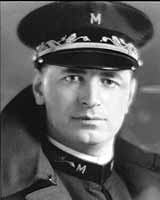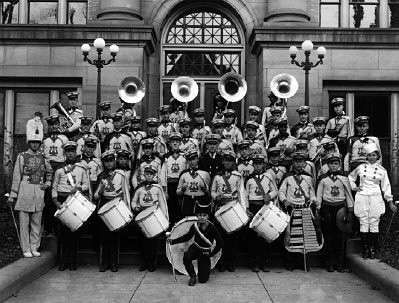Birth of the Band
part 3
After Maddy's departure the band and orchestra became more distinct, with different conductors, different rehearsal times, and different members. But in a reprise of Maddy's double duty, Nicholas Falcone, the newly hired Director of Bands at the U-M,  also directed the band at Ann Arbor High for the 1927–1928 school year.
also directed the band at Ann Arbor High for the 1927–1928 school year.
This was the same year that the Michigan Stadium opened, and Falcone was busy introducing military-style drill into the Michigan Marching Band's on-field performances. He soon found his work at the U-M consumed all his time, so he did not continue in the high school position. Falcone remained at the U-M for several more years, but was forced to resign by a tragic hearing loss; his successor was the legendary bandleader William Revelli.
Nicholas Falcone
Falcone's successor at Ann Arbor High, William Champion, was the first of many long-serving directors, all of whom built the band program's high standards, traditions, and strong esprit de corps. Champion expanded the band program, oversaw the admittance of the first female musicians, and gave the marching band a snappy military style. He also worked to make the band a strong concert ensemble, adding instruments not used in marching like the oboe, the bassoon, and the alto and bass clarinet. Champion also started band programs in the elementary and junior high schools.
Under Champion the students presented the first "Band Frolic," which included several novelty acts along with the standard concert music. After a few years, this gave way to a more formal performance, which continues to this day in the form of the high schools' Winter Band Concert. Champion had also taken over the direction of the orchestra in 1930, but whether his style or other circumstances were to blame, orchestra membership dwindled until the band was twice its size. He must have been a capable orchestral conductor, however, as he also directed the Ann Arbor Symphony Orchestra from 1933 to 1941.

1935 Ann Arbor High School Band under William Champion
The tradition of marching from the high school to the football games was established during Champion's tenure. Local radio personality Ted Heusel, who played trombone in the band in the 1930s, recalls that the musicians would march down Huron and Main streets to Wines Field (now Elbel Field on Hill St. where the Michigan Marching Band practices). Heusel remembers how deliciously distracting the smell wafting from Quality Bakery was as the band passed by its building on Main near William (now Palio restaurant). Champion also instituted the "AA" formation on the field, which continued until 1969, when the division of the school into Pioneer and Huron high schools forced a change to separate "P" and "H" formations.
Champion, an officer in the naval reserves, was called to active duty in 1941. Once again, the world at war seems to have an impact on the numbers of students involved in band: from a high of fifty-eight under Champion, membership dropped to thirty-seven under new director E. Rollin Silfies. Silfies introduced new formations to the marching band, but after his first year the orchestra was handed over to newly hired Elizabeth Green, who would rebuild the program into the first-rate institution that we still enjoy today. Between the war and bad weather that limited the band's appearances at football games, it seems that Silfies second year was even less successful; he left Ann Arbor at the end of the 1942–43 school year.
Charles M. Yates, the director for the next three years, seemed to regain some ground in student numbers and in the concert performance level of the band, which even participated in the U-M May Festival at Hill Auditorium. For reasons that are unclear, however, Yates left at the end of 1945–1946 school year.
